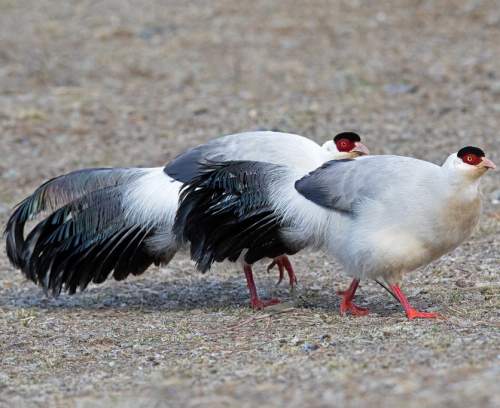Taxonomic classification < > Photos
The Kalij pheasant (Lophura leucomelanos) belongs to the family Phasianidae under the order Galliformes.
Kalij pheasant taxonomy
The Phasianidae is a family of ground-living birds like partridges, tragopans, junglefowls, peafowls and chickens.The family Phasianidae was first introduced by Thomas Horsfield M.D. (May 12, 1773 – July 24, 1859), an American physician and naturalist, in the year 1821.
The family Phasianidae is tentatively divided into four subfamilies, viz., Perdicinae, Meleagridinae, Phasianinae and Tetraoninae. The subfamily Phasianinae was described by Thomas Horsfield.
The subfamily Phasianinae comprises sixteen genera, including genus Lophura. The genus Lophura was introduced by John Fleming DD FRSE FRS FSA (10 January 1785 – 18 November 1857), a Scottish minister, naturalist, zoologist and geologist, in the year 1822.
The genus Lophura is polytypic and comprises ten species including Lophura leucomelanos. The species Lophura leucomelanos was introduced by John Latham (27 June 1740 – 4 February 1837), an English physician, naturalist and author, in the year 1790.
| Taxonomic classification | |
|---|---|
| Binomial name: | Lophura leucomelanos |
| Species: | L. leucomelanos |
| Genus: | Lophura |
| Subfamily: | - |
| Family: | Phasianidae |
| Order: | Galliformes |
| Class: | Aves |
| Phylum: | Chordata |
| Kingdom: | Animalia |
 |
| 1.Kalij pheasant - Lophura leucomelanos 298 Photo by Jason Thompson |
 |
| 2.Kalij pheasant - Lophura leucomelanos Photo by Mprasannak |
 |
| 3.Kalij pheasant - Lophura leucomelanos Photo by Minette Layne |
 |
| 4.Kalij pheasant - Lophura leucomelanos Photo by Mprasannak |
 |
| 5.Kalij pheasant - Lophura leucomelanos Photo by Dibyendu Ash |
 |
| 6.Kalij pheasant - Lophura leucomelanos Photo by Sanjeevburman76 |
 |
| 7.Kalij pheasant - Lophura leucomelanos Photo by David Cook |
 |
| 8.Kalij pheasant - Lophura leucomelanos Photo by Lip Kee |
 |
| 9.Kalij pheasant - Lophura leucomelanos Photo by Siddhesh Sawant |
1.Photo source: https://www.flickr.com/photos/79492850@N00/8532366319 (cropped)
Author: Jason Thompson | License: CC BY 2.0 as on 5/30/18
2.Photo source: https://en.wikipedia.org/wiki/File:Kalij_pheasant_Prasanna_Mamidala.jpg (cropped)
Author: Mprasannak | License: CC BY-SA 4.0 as on 5/30/18
3.Source: https://www.flickr.com/photos/minette_layne/14273975433/ (cropped)
Author: Minette Layne | License: CC BY-NC 2.0 as on 5/30/18
4.Photo source: https://commons.wikimedia.org/ (cropped)
Author: Mprasannak | License: CC BY-SA 4.0 as on 5/30/18
5.Source: https://en.wikipedia.org/ (cropped)
Author: Dibyendu Ash | License: CC BY-SA 3.0 as on 5/30/18
6.Source: https://commons.wikimedia.org/ (cropped)
Author: Sanjeevburman76 | License: CC BY-SA 4.0 as on 5/30/18
7.Source: https://www.flickr.com/photos/kookr/41480843524/ (cropped)
Author: David Cook | License: CC BY-NC 2.0 as on 5/30/18
8.Source: https://www.flickr.com/photos/lipkee/2435806401/ (cropped)
Author: Lip Kee | License: CC BY-SA 2.0 as on 5/30/18
9.Source: https://commons.wikimedia.org/wiki/File:Lophura_leucomelanos.jpg (cropped)
Author: Siddhesh Sawant | License: CC BY-SA 4.0 as on 5/30/18
Current topic in Birds of India: Kalij pheasant - Lophura leucomelanos photos.
























